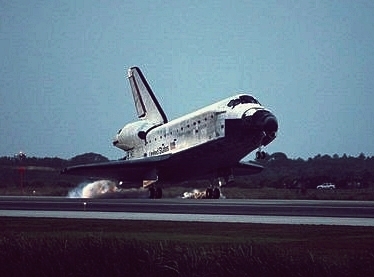
 Shuttle Discovery Touching Down. Shuttle Discovery is touching down on Runway 15 at NASA Kennedy Space Center's Shuttle Landing Facility on December 22nd. A feeling of might is emanating from this picture! Shuttle Discovery is seen here as it returns from the Space Shuttle STS-116 mission to the International Space Station (ISS). This mission of the Space Shuttle was aiming to continue to build the space outpost. With three spacewalks performed, the STS-116 mission performed an important work, installing new solar array and, above all, rewiring the ISS to new, permanent, power sources, paving the way to additional solar arrays to be installed up there by the following missions. An additional spacewalk was needed however, as some solar panels had troubles to get folded, bringing to that two astronauts had to help to that! Like for every Space Shuttle mission returning from the ISS, Shuttle Discovery spent two days in orbit for preparations and checks before re-entering the Earth atmosphere. This protocol has been put into place following the dramatic loss of Shutlle Columbia in February 2003 as its was in this process of re-entering Earth and that some damage to the wing allowed extreme warm air to get into, and have the shuttle destroyed. As the flight of the Space Shuttle during reentry is conducted in the autopilot mode, it's the commander who takes command from when the Shuttle reaches an altitude of 50,000 ft and a speed under Mach 1. Using an instrument landing system, the commander eventually get the orbiter aligned with the runway at the KSC's Shuttle Landing Facility, and he has the shuttle touching down. The touchdown occurs at a speed of 220 mph (about 190 knots, 354 km/h), as a parachute deploys, braking the speed and allowing the nose of the Shuttle to lower. The Space Shuttle keeps rolling for a 1.5 mile (2.4 km) as it eventually comes to a slow stop by the end of the runway. picture courtesy NASA
Shuttle Discovery Touching Down. Shuttle Discovery is touching down on Runway 15 at NASA Kennedy Space Center's Shuttle Landing Facility on December 22nd. A feeling of might is emanating from this picture! Shuttle Discovery is seen here as it returns from the Space Shuttle STS-116 mission to the International Space Station (ISS). This mission of the Space Shuttle was aiming to continue to build the space outpost. With three spacewalks performed, the STS-116 mission performed an important work, installing new solar array and, above all, rewiring the ISS to new, permanent, power sources, paving the way to additional solar arrays to be installed up there by the following missions. An additional spacewalk was needed however, as some solar panels had troubles to get folded, bringing to that two astronauts had to help to that! Like for every Space Shuttle mission returning from the ISS, Shuttle Discovery spent two days in orbit for preparations and checks before re-entering the Earth atmosphere. This protocol has been put into place following the dramatic loss of Shutlle Columbia in February 2003 as its was in this process of re-entering Earth and that some damage to the wing allowed extreme warm air to get into, and have the shuttle destroyed. As the flight of the Space Shuttle during reentry is conducted in the autopilot mode, it's the commander who takes command from when the Shuttle reaches an altitude of 50,000 ft and a speed under Mach 1. Using an instrument landing system, the commander eventually get the orbiter aligned with the runway at the KSC's Shuttle Landing Facility, and he has the shuttle touching down. The touchdown occurs at a speed of 220 mph (about 190 knots, 354 km/h), as a parachute deploys, braking the speed and allowing the nose of the Shuttle to lower. The Space Shuttle keeps rolling for a 1.5 mile (2.4 km) as it eventually comes to a slow stop by the end of the runway. picture courtesy NASA
 La navette Discovery à l'atterrissage
La navette Discovery à l'atterrissage
Une impression de puissance se dégage de cette vue de la navette spatiale atterrissant sur la piste de la Landing Shuttle Facility du Kennedy Space Center! La navette -qui est la navette Discovery- revient de la mission STS-116 à la Station Spatiale Internationale (ISS) et elle atterrit sur la piste 15. Nous sommes le 22 décembre 2006. Cette mission de la navette spatiale marquait la suite des travaux de construction à l'ISS. En trois sorties dans l'espace, les astronautes ont installé de nouveaux panneaux solaires et branché la Station Spatiale sur ses sources d'alimentation permanentes. Ce branchement va maintenant permettre aux missions suivantes de continuer d'installer des panneaux solaires supplémentaires. Un panneau solaire ancien refusant de se replier a nécessité une sortie dans l'espace additionnelle. Comme lors du retour de chaque mission, la navette a passé deux jours en orbite avant de ré-entrer dans l'atmosphère terrestre. Ce protocole, qui permet de préparer et vérifier la navette, a été mis en place du fait de l'accident qui avait coûté la vie à l'équipage de la navette Columbia en février 2003: un dommage subi par l'aile au décollage avait, lors de la ré-entrée, laissé l'air brûlant de l'atmosphère terrestre pénétrer dans la structure, détruisant la navette. Le vol de ré-entrée s'effectue en pilote automatique. Le commandant de la mission ne prend le contrôle qu'à partir de 50,000 pieds -la navette, alors, a repassé la barre des 1 Mach. Utilisant un système d'approche aux instruments, le commandant aligne la navette avec la piste de la Shuttle Landing Facility et il atterrit. La navette, à l'atterrissage, a une vitesse de 190 noeuds (354 km/h)! Un parachute se déploie et freine la navette, ce qui abaisse le nez. La navette continue de rouler pendant encore 2,4 km (1,5 mile). NASA
Website Manager: G. Guichard, site 'Amateur Astronomy,' http://stars5.6te.net. Page Editor: G. Guichard. last edited: 12/28/2010. contact us at ggwebsites@outlook.com


![]() La navette Discovery à l'atterrissage
La navette Discovery à l'atterrissage